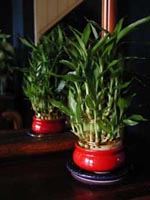Resource Library
Plant of the Week: Lucky Bamboo
The University of Arkansas System Division of Agriculture does not promote, support or recommend plants featured in "Plant of the Week." Please consult your local Extension office for plants suitable for your region.
Plant of the Week
Lucky Bamboo
Latin: Dracaena sanderana

Feeling lucky? If not, maybe you better invest in a lucky bamboo so you can attract good vibes your way. Lucky bamboo, not a bamboo at all but cane cuttings of Dracaena sanderana, has swept the country in the last decade. Though it’s just an insignificant little plant, we can use it as an example of how products and new ideas are integrated into our culture.
Dracaena sanderana is native to Cameroon in equatorial West Africa. While it has the
general characteristics of larger, more common dracaenas, this species only grows
about 3 feet tall with finger-size stems.
Lucky bamboo’s rise to stardom in the horticultural world is a sign of the multinational
world we now live in. It’s a fusion of eastern mysticism, western New Age culture,
good marketing savvy and the laws governing plant importation.
The eastern mysticism angle involves the Chinese cultural identification with bamboo. Bamboo, since Confucian times, has been identified with strength and fortitude. Though bamboo may be blown down in the storms of life, after they pass, the resilient plant rights itself and goes on, just as we must do when faced with adversity.
This association with bamboo is further amplified by the art of Feng Shui, which is a traditional Chinese method of ordering one’s life to attract positive chi (force) to you. As near as I can tell, Feng Shui is a marriage of sound design principles and good old fashioned superstition to create comfortable, healthy and profitable spaces in which to live and work.
Feng Shui was adopted by the California New Age culture 30 years ago and has since spread throughout the land. Lucky bamboo fits right into the Feng Shui system because of the old association with bamboo and the fact that green is a lucky color. It’s a kind of lightning rod attracting positive chi your way.
Now, we must consider the marketing angle. While bamboo would be the preferred plant to use, it simply won’t work because when it is cut off, the stem is dead. So, at some point, an insightful Chinese businessman thought, "Let’s strip the leaves off of Dracaena sanderana stems and substitute it for bamboo. They look alike." Thus an industry was born. I have no information if the dracaena version of "lucky bamboo" is used in Chinese homes, and would be interested in hearing from anyone with knowledge on this point.
Plant people in Asia have largely lost out on trade with the West because plant quarantine laws prohibit importation of plants bearing soil into the country. But unrooted stem cuttings of lucky bamboo can be imported without restrictions. Even with the cost of shipping, the 50-cent per day wage rate and the tropical climes keep production costs low.
This is one tough little plant, and it is easy to keep it going for a year or more in just water. But eventually it will start to decline if held in just plain water, so nutrition must be supplied occasionally. A diluted solution of liquid houseplant fertilizer every couple months should do the trick.
Two problems occur on this dracaena. Spider mites can become a serious problem; sometimes building up to such high populations they cause webbing. Washing the leaves off can control them. The second problem is a leaf tip burn caused by either high salts or high fluoride concentrations in the water. Using rainwater to fill the container is a good way of avoiding these problems.
The cuteness of lucky bamboo and its symbolism diminishes as the plant begins growing and gets leggy or the leaves become tattered. When it gets a bit ugly and needs pruning, consider cutting the canes back to their original length when first potted in China. This will let the plant start over and no doubt restore balance to your life and home.
By: Gerald Klingaman, retired
Extension Horticulturist - Ornamentals
Extension News - December 3, 2004
The University of Arkansas System Division of Agriculture does not maintain lists of retail outlets where these plants can be purchased. Please check your local nursery or other retail outlets to ask about the availability of these plants for your growing area.